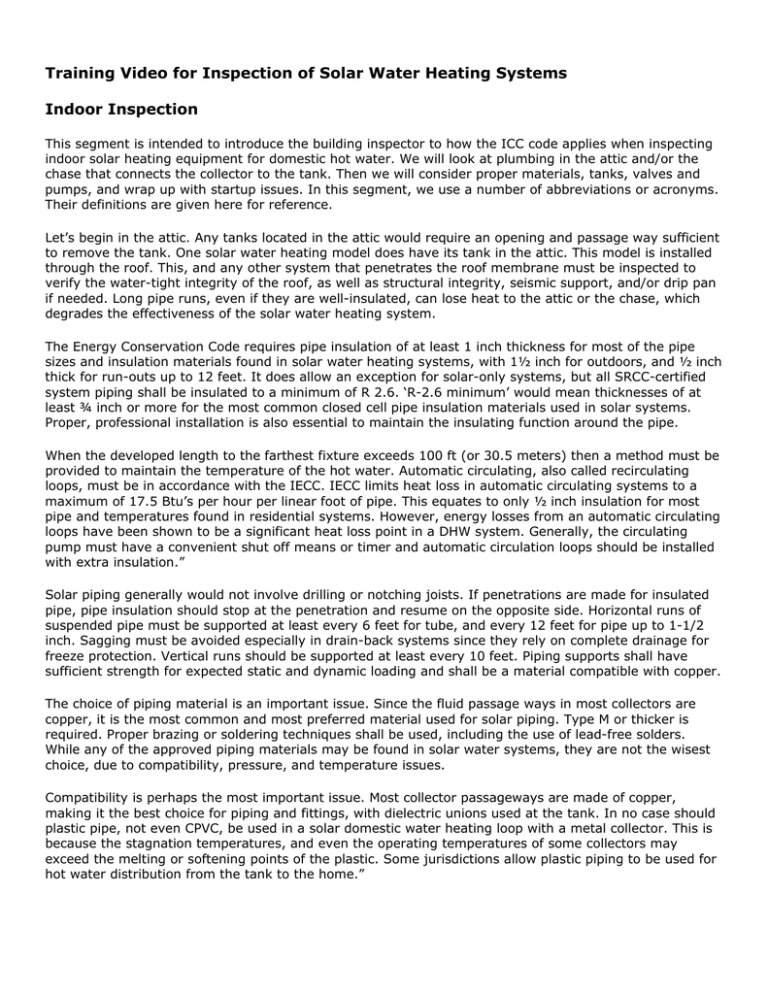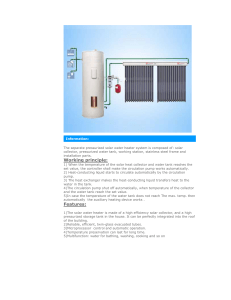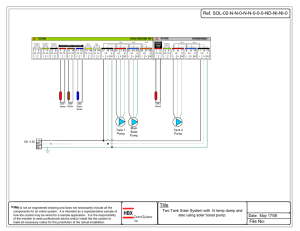Training Video for Inspection of Solar Water Heating Systems
advertisement

Training Video for Inspection of Solar Water Heating Systems Indoor Inspection This segment is intended to introduce the building inspector to how the ICC code applies when inspecting indoor solar heating equipment for domestic hot water. We will look at plumbing in the attic and/or the chase that connects the collector to the tank. Then we will consider proper materials, tanks, valves and pumps, and wrap up with startup issues. In this segment, we use a number of abbreviations or acronyms. Their definitions are given here for reference. Let’s begin in the attic. Any tanks located in the attic would require an opening and passage way sufficient to remove the tank. One solar water heating model does have its tank in the attic. This model is installed through the roof. This, and any other system that penetrates the roof membrane must be inspected to verify the water-tight integrity of the roof, as well as structural integrity, seismic support, and/or drip pan if needed. Long pipe runs, even if they are well-insulated, can lose heat to the attic or the chase, which degrades the effectiveness of the solar water heating system. The Energy Conservation Code requires pipe insulation of at least 1 inch thickness for most of the pipe sizes and insulation materials found in solar water heating systems, with 1½ inch for outdoors, and ½ inch thick for run-outs up to 12 feet. It does allow an exception for solar-only systems, but all SRCC-certified system piping shall be insulated to a minimum of R 2.6. ‘R-2.6 minimum’ would mean thicknesses of at least ¾ inch or more for the most common closed cell pipe insulation materials used in solar systems. Proper, professional installation is also essential to maintain the insulating function around the pipe. When the developed length to the farthest fixture exceeds 100 ft (or 30.5 meters) then a method must be provided to maintain the temperature of the hot water. Automatic circulating, also called recirculating loops, must be in accordance with the IECC. IECC limits heat loss in automatic circulating systems to a maximum of 17.5 Btu’s per hour per linear foot of pipe. This equates to only ½ inch insulation for most pipe and temperatures found in residential systems. However, energy losses from an automatic circulating loops have been shown to be a significant heat loss point in a DHW system. Generally, the circulating pump must have a convenient shut off means or timer and automatic circulation loops should be installed with extra insulation.” Solar piping generally would not involve drilling or notching joists. If penetrations are made for insulated pipe, pipe insulation should stop at the penetration and resume on the opposite side. Horizontal runs of suspended pipe must be supported at least every 6 feet for tube, and every 12 feet for pipe up to 1-1/2 inch. Sagging must be avoided especially in drain-back systems since they rely on complete drainage for freeze protection. Vertical runs should be supported at least every 10 feet. Piping supports shall have sufficient strength for expected static and dynamic loading and shall be a material compatible with copper. The choice of piping material is an important issue. Since the fluid passage ways in most collectors are copper, it is the most common and most preferred material used for solar piping. Type M or thicker is required. Proper brazing or soldering techniques shall be used, including the use of lead-free solders. While any of the approved piping materials may be found in solar water systems, they are not the wisest choice, due to compatibility, pressure, and temperature issues. Compatibility is perhaps the most important issue. Most collector passageways are made of copper, making it the best choice for piping and fittings, with dielectric unions used at the tank. In no case should plastic pipe, not even CPVC, be used in a solar domestic water heating loop with a metal collector. This is because the stagnation temperatures, and even the operating temperatures of some collectors may exceed the melting or softening points of the plastic. Some jurisdictions allow plastic piping to be used for hot water distribution from the tank to the home.” If the water supply tends to be aggressive, an indirect system must be installed. An indirect system with a heat exchanger protects the small collector passageways from scaling or corrosion caused by aggressive water. Although solar hot water systems do not have the same location restrictions that fuel-fired systems requiring combustion air have, for aesthetics reasons the indoor components of solar systems are generally found next to the conventional system or where the conventional system would normally be found, such as in the utility room or garage. In addition, solar pre-heat tanks should be located nearby the conventional tank to reduce line losses between the two. Further, in hot and humid climates it is sometimes beneficial to locate these appliances in unconditioned space to reduce air conditioning load. If located outside, the equipment should be protected from weather.” Solar systems shall be maintained in proper safe and sanitary operating condition, and the owner shall be responsible for maintenance. While the potential for unsafe fire hazard is very limited with solar systems, there is a potential for unsafe conditions resulting from improper plumbing or installation, such as incorrectly installed valves or vents. Check valves must be installed in the correct orientation with the arrow in the direction of flow. Some check valves operate only horizontally, and must be plumbed as such, others operate only vertically. Some are weighted, while others are spring loaded. Still others are mechanical or motorized. These are normally closed, they open only when the pump is energized. Pressure relief valves must not be able to be isolated from the source of heat. Like other mechanical systems, solar systems may need to be tested as part of inspection. Any testing procedures will be defined in the installation manual. At a minimum, the solar system should be pressure tested to check for leaks. Also, air will need to be removed and the collector loop filled to the specified level and pressure. For some systems such as glycol, this can involve a filling sequence of several steps.” As in conventional systems, the potable water supply shall be protected against contamination in accordance with the plumbing code. In certified direct systems where the collector loop is exposed to the potable water, all materials and components will have been checked for compatibility with potable water. In certified INdirect systems, a non-potable heat transfer fluid may be used as long as it is separated from the potable water supply by a double walled heat exchanger with leak detection. ‘Double-walled’ means that there are two heat transfer surfaces between the hot collector fluid and the cool potable water, usually with a small annular passage between the two surfaces. This is so that if one side ruptures, corrodes or is otherwise compromised, then the fluid will leak into the annular passage and out into the open before the second wall is compromised. As on the roof, all sections of the plumbing loop capable of developing pressure shall have a relief device. This would include the tank, and the collector loop if the collector loop can be isolated from the tank. To protect the collector loop, the relief valve should be on the hot side of any check valve. Cold-side or potable-side heat exchanger loops normally are protected by the conventional tank relief valve. Relief valves and discharge must meet Code. Relief valves located near the collector should be pressure-relief only since they may otherwise pop off during stagnation conditions. Temperature relief valves shall have a temperature setting of not more than 210 degrees F. They shall have a pressure setting not exceeding the manufacturer’s working pressure or 150 psi, whichever is less. Water heaters shall be third-party certified and installed per manufacturer’s instructions. Tanks shall have maximum allowable working pressure clearly and indelibly marked. The cold water line supplying the heater or tank shall have a valve to isolate the tank without interfering with the cold water supply. Drain valves conforming to ASSE 1005 shall be installed at the bottom. And as with conventional water heaters, a means shall be provided for disconnecting the backup energy source, whether a switch for electrical backup or a valve for other backup fuel sources. Where leakage could cause damage, tanks and heaters shall have an appropriate pan with drainage. Components that can not withstand any design vacuum conditions shall be protected with a vacuum relief valve. SRCC certified systems meet this requirement, but proper installation must be confirmed. This would include tanks or heaters that are bottom fed, or systems that are bottom feed-bottom return if there is no other egress at the top. In addition, a cold water dip tube with a hole at the top may be required to avoid siphoning. In addition to pressure relief, expansion tanks are required take care of daily pressure fluctuations on liquid single-phase solar systems, which are most of the systems encountered today. Normal sizing procedures apply just as for conventional tanks. Note that in a direct system, the collectors and piping will generally add no more than a few gallons to the solar storage tank’s volume. In an indirect system, the collector loop usually will require its own expansion tank if it is not a drainback system. In some cases a pressure reducing valve and/or a backflow prevention device might be required. Solar storage tanks are subject to the same requirements as conventional storage tanks. Pressurized tanks must be listed and labeled with operating parameters stipulated. These would include any solar storage tank that is in the potable water loop and subject to city or mains water pressure. A single-tank system is of course a pressurized potable tank. Recall that the solar loop heats the lower two-thirds and the upper electric element heats the upper one-third. In a two-tank system, both the solar storage tank and the conventional storage tank would hold pressurized heated potable water. Note that the collector loop might not be pressurized. A drain back system is one example. Here, the collector loop may not be at city pressure, and the small drain back tank may not need to be rated. The collector loop might still need to have pressure relief set below the pressure rating of the drain back tank. Solar pumps are generally indoor-rated and located next to the tank for convenience of installation. Any pump or other component located outdoors must be rated for outdoor use. If the system is an active, or pumped system using a differential controller, then you will find the cold temperature sensor at or near the bottom of the solar storage tank. Sometimes the sensor might be attached to a tank sensor stud, if one is supplied with the tank. Generally, this sensor is a small thermistor clamped to the pipe that is in good thermal contact with the pipe, underneath the insulation, and as close as possible to, but no more than 12 inches away from, the tank cold outlet to solar supply. To ensure good thermal contact, thermistor type sensors should be screwed or clamped at the flat sensor end, and not around the sensor ‘barrel’. The storage tank and pump area is a good place to verify that the system is charged with the heat transfer fluid specified in the certified design. The certification review has already checked the compatibility, flammability and flash point of the heat transfer fluid. However it is useful to understand the application of the Code here. A flammable liquid or gas shall not be used as a heat transfer fluid. Further, the liquid flash point shall be at least 50 degrees Fahrenheit above the system’s design maximum nonoperating temperature, which is usually 300 to 350 degrees, but may be has high as 400 F. While the flash point of pure propylene glycol is only 216 degrees F, mixtures of propylene glycol and water up to 80% glycol concentration are NOT flammable because they have NO measurable flash point. One may require a sample of the fluid and check the specific gravity using a simple hydrometer to determine the concentration. Glycol mixtures should be at the concentration required for freeze protection in that region, but at least 25% concentration for proper corrosion inhibition, and never more than 60% concentration. Concentrations of 80-100% glycol become flammable and shall not be allowed in solar domestic water heating systems. Certified solar DHW systems do not recommend glycols in applications that are expected to see very high stagnation temperatures or non-continuous use. They require that the owner’s manual provide procedures for fluid replacement after boil-over or at regular intervals. At high temperatures, glycols tend to oxidize and lose their corrosion inhibitors, requiring replacement. The type of glycol sometimes can be determined by color and labeling on the container. For example, DowFrost is usually a clear water-white color, and DowFrost HD is fluorescent yellow. Sierra brands of propylene glycol may be fluorescent green. If DowFrost HD or other fluid with extra inhibitors is the required heat transfer fluid, SRCC requires that a double walled heat exchanger be used. In residential solar DHW systems, ethylene glycol should not be used due to toxicity concerns, and silicone oils must not be used due to flammability concerns. Standard off-the-shelf automotive glycols available in hardware stores may not be suitable, since their inhibitors may produce a sludge in the presence of copper. Glycols with inhibitors designed for HVAC systems should be specified. Certified glycol systems shall have proper labels identifying the required heat transfer fluid and concentration, also warning against using other fluids. And of course. distilled or deionized water should always be used to mix the glycol solutions.” It is recommended that systems be designed to stop back-siphoning, sometimes referred to as ‘reverse thermosyphon’. This might be addressed with a bottom-feed-bottom-return from the collector to the tank, which may then require a vacuum relief. Side-returns and top-returns are much more common and should incorporate check valves and/or heat loops, as should bottom-return designs with multiple tanks. These issues will have been checked at the design level for certified systems. As with conventional heating tanks, vertical pipe risers shall have a heat trap on both the inlet and the outlet of the water heater unless it has an integral heat trap or is part of a circulating system. Note that this is not required by SRCC; rather the hot line and the last five feet of the cold line must be insulated to specifications. Access shall be provided to solar energy equipment and appliances for maintenance. This would mean that controllers should be visible and accessible, as should pumps and valves or fittings that may require maintenance. Certified systems will have monitoring and maintenance instructions in the mandatory owner’s manual. Although access to the collector on the roof from time to time is important, the issue of access is usually more of a problem in the utility room. Monitoring the system usually would involve checking pumps and temperature sensors for proper operation. Maintenance of the system might include periodic draining to flush the conventional tank, replacement of glycol periodically or after boil-over, replacement of a failed pump, or PT valve, temperature sensor, sacrificial anode, or heating element. All of these actions require sufficient space for any tools, hoses, buckets, prime pumps or other equipment, as well as space for the technician to perform the maintenance. A clean, professional appearance is a good sign of a properly installed system, and a properly installed system usually means a happy homeowner. As I hope you have seen in this segment, inspecting the indoor portion of a solar DHW system is not much different from inspecting a conventional DHW system. I hope that this and the other segments have been informative and have given you an idea of what you can expect to find in the field. Be sure to refer back to these segments as the need arises, and feel free to contact the SRCC or the Florida Solar Energy Center with comments and questions.


